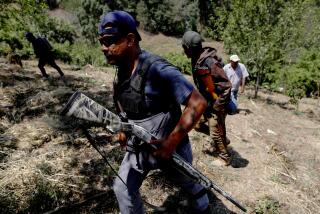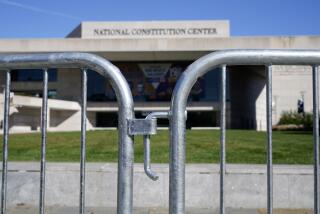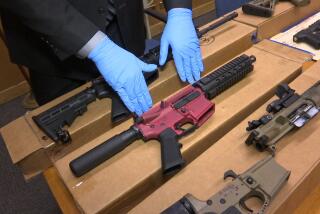Column: Sanders got the gun makers’ liability issue dead wrong (and got an attaboy from the NRA)
- Share via
One of the most contentious exchanges at Sunday’s presidential debate between Sen. Bernie Sanders and former Secretary of State Hillary Clinton involved guns. The issue boiled down to Sanders’ 2005 vote in Congress to limit liability for gun sellers and manufacturers whose products get used in a crime.
As he has in the past, Sanders defended his vote by suggesting that the gun industry wouldn’t survive the imposition of liability for the crimes of others. The issue, he said, was that “if somebody who is crazy or a criminal or a horrible person goes around shooting people, the manufacturer of that gun should be held liable.... What you’re really talking about is people saying let’s end gun manufacturing in America. That’s the implications of that, and I don’t agree with that.”
What you’re really talking about is people saying let’s end gun manufacturing in America. That’s the implications of that, and I don’t agree with that.
— Sen. Bernie Sanders, Democratic presidential candidate
His stand won the praise of the National Rifle Assn., which tweeted Sunday night that Sanders was “spot-on in his comments about gun manufacturer liability.” He also garnered the condemnation of the Brady Campaign to Prevent Gun Violence, which said in a statement Monday that “he can either stand with American families torn apart by gun violence, or he can stand with the NRA.”
The law at the heart of the debate is the Protection of Lawful Commerce in Arms Act, a measure championed by the NRA, which called its passage “an historic victory.” The bill was signed into law by President George W. Bush. Hillary Clinton, who then represented New York in the Senate, voted against it.
Would overturning PLCAA really “end gun manufacturing in America”? That’s highly doubtful. Before we examine why, let’s look at the background to the law and where things stand on liability for gun makers.
PLCAA came before Congress at a time when gun makers had good reason to fear that the tide was on the verge of turning against them in court. During the 1980s, victims of gun violence had been bringing negligence cases, chiefly against retailers who had sold guns to unfit customers, such as intoxicated, visibly deranged buyers or those declaring their intention to shoot someone. Some lawsuits were successful.
The victims then trained their attention on manufacturers. A key moment had come in 1985 in Maryland, where the state’s highest court had upheld a judgment against the maker of a Saturday Night Special used to shoot a grocery store worker in the chest.
The guns were cheap, easily concealable and so inaccurate that they were useless for any legitimate activity, the court found; the manufacturer “knows or ought to know that the chief use of the product is for criminal activity.”
The gun lobby swung into action, and within a year the Maryland legislature passed a law overturning the strict-liability doctrine upon which the lawsuit was based.
The next wave of cases was brought by municipalities and other governmental bodies on the theory that the gun industry had created a public nuisance. “The idea was that selling weapons into urban centers that created crime was a type of pollution,” says Timothy D. Lytton, a gun regulation expert at Georgia State University law school.
The first major case was brought by Philadelphia under its then-Democratic Mayor Ed Rendell and was followed by about 30 more. The Clinton administration, after it threatened to join the case, reached an agreement with Smith & Wesson that the gun maker would restrict the terms of its retailers’ sales and to equip its products with safety features.
The nuisance theory got some support from Federal Judge Jack B. Weinstein of Brooklyn, who ruled in 2003 in a case brought by the NAACP that the gun manufacturers were “responsible for the creation of a public nuisance and could — voluntarily and through easily implemented changes in marketing... substantially reduce the harm” stemming from the diversion of guns into the illegal market. Weinstein, who was known to be sympathetic to gun victims in such cases, threw out the lawsuit on technical grounds, but his massive 261-page ruling amounted to “a blueprint for bringing a successful public nuisance claim against the industry,” Lytton wrote later.
The NRA was again at work: 33 state legislatures passed laws giving gun makers immunity from such lawsuits. The effort culminated with the passage of PLCAA, which stopped the lawsuits dead. In the meantime, the NRA and other gun lobbies had mounted a devastating boycott of Smith & Wesson. The company was later sold, and its agreement with the government fell apart after George W. Bush was elected president.
PLCAA doesn’t give gun manufacturers and sellers absolute immunity from lawsuits. There are a handful of exceptions, including cases in which the seller knew the gun would be used in a crime, the buyer was obviously unsuitable, the sale violated the law or the injury resulted from a manufacturing defect. The exemptions played into a jury award last October of $5.7 million to two injured Milwaukee police officers, who sued the store that sold the gun used to shoot them. At trial, it was shown that the store clerk couldn’t be unaware that the 21-year-old buyer was acting as the “straw buyer” for an 18-year-old, who was with him in the store and picked out the gun.
Several Sandy Hook families are hoping to use another exemption known as “negligent entrustment” in a lawsuit against the maker of the Bushmaster semiautomatic rifle used by Adam Lanza in the bloodbath at their children’s school in December 2012. A state judge in Connecticut is due to rule any day on whether the case should proceed.
The plaintiffs’ argument is that the maker and seller of the gun, a scarcely altered knockoff of a military weapon, had to know that it was unsuitable for sale to anyone but military or law enforcement personnel. Instead it was marketed to civilian military wannabes with no legitimate use for the weapon, with pitches that lauded it as “the uncompromising choice when you demand a rifle as mission-adaptable as you are” and touted its “military-proven performance.”
What about Sanders’ contention that expanding liability for gun makers and sellers would destroy the gun industry in the U.S.? Lytton is skeptical. He argues that being saddled with greater liability would give manufacturers greater incentive to monitor the behavior of their retailers.
“The theories being brought against the gun industry are primarily negligence theories,” Lytton says. “And there are many things the industry could do to satisfy the standard of care in a negligence claim and therefore not be liable. Industries police their distribution channels all the time to protect themselves from liability, and it doesn’t drive them out of business — it just makes the industry less risky.” The gun shop in the Milwaukee case, for instance, was notorious as a source of illegal guns; nothing would have kept manufacturers from cutting off its supply.
PLCAA arguably made the gun industry more dangerous by removing any incentive for manufacturers to pay attention to how their products get sold, and to whom. “Sen. Sanders voted for a bill that had these exceptions” to immunity, Lytton points out. “So he did accept that there should be a certain amount of liability exposure in the gun industry. He just wanted to roll it back to the early 1980s.”
Keep up to date with Michael Hiltzik. Follow @hiltzikm on Twitter, see our Facebook page, or email [email protected].
More to Read
Inside the business of entertainment
The Wide Shot brings you news, analysis and insights on everything from streaming wars to production — and what it all means for the future.
You may occasionally receive promotional content from the Los Angeles Times.










